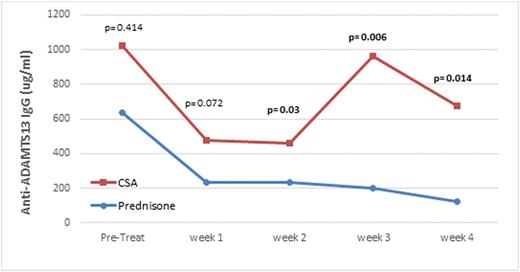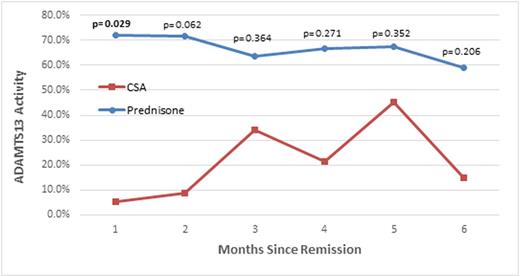Abstract
INTRODUCTION: A prospective, randomized study (NCT00713193) was undertaken to compare the efficacy and safety of cyclosporine (CSA) and prednisone (P) as adjuncts to plasma exchange therapy (PEX) in the treatment of acquired TTP. The primary objective was to determine if CSA or P given as an adjunct to PEX has a lower exacerbation rate. Secondary endpoints included the effect of CSA and P on the ADAMTS13 activity and anti-ADAMTS13 antibody concentration and their relationship to clinical outcomes.
METHODS: Patients were randomized 1:1 to CSA (2-3mg/kg/d orally) or P (1mg/kg/d orally) with daily PEX until response was achieved (normal platelets , LDH). After stopping PEX CSA was continued for 6 months; P was continued at full dose for the first 4 weeks, then tapered over 4 weeks. Exacerbation was defined as recurrent thrombocytopenia requiring PEX <30 days after the last PEX, with relapse defined as recurrence >30 days after the last PEX. ADAMTS13 biomarkers were obtained pretreatment, weekly for 4 weeks after the last PEX, monthly for 5 months, and then every 3 months until 42 months of follow-up.
RESULTS: Since November 2007, 26 patients were randomized to CSA (n=12) or P (n=14) and followed for a median 42 m. (range, 1 -42). The study was halted after a planned interim analysis. Response rates were comparable in both arms (CSA: 11/12(92%); P:11/14,(79%);p=0.2), with one patient dying on each arm before achieving a response, and 2 P treated patients crossing over to the CSA arm after failing to achieve a response. The exacerbation rate on the CSA arm was 3/11(27%) v. 1/11(9%) on the P arm (p=0.3). Relapses in patients that achieved remission (without exacerbation) occurred in 5/8 CSA treated patients and 4/10 P treated patients at a median of 7 m. (range, 3-39) and 16m. (range, 4-26), respectively. Serial measurements of the ADAMTS13 activity and IgG inhibitor concentrations over the first 30 days after the last PEX and over the 6 m. CSA treatment course are show in Figures 1 and 2.
CONCLUSIONS: There was no significant difference in the exacerbation rate between the CSA and P arms. However, improvement in the ADAMTS13 activity and suppression of the anti-ADAMTS13 antibodies were significantly better in the P arm compared to the CSA-treated patients. These ADAMTS13 activity and inhibitor concentration data for the first time provide support for the efficacy of P as an adjunct to PEX, and the superiority of P over CSA as an adjunct to PEX therapy in the initial treatment of acquired TTP.
Pretreatment and serial measurements of the median ADAMTS13 activity and ADAMTS13 autoantibodies over the first weeks after stopping PEX therapy
Pretreatment and serial measurements of the median ADAMTS13 activity and ADAMTS13 autoantibodies over the first weeks after stopping PEX therapy
Serial measurement of the median ADAMTS13 activity over the 6 months CSA dosing period of patients with a continuous remission. Patients were censored at the time of clinical events (crossover, exacerbation, relapse).
Serial measurement of the median ADAMTS13 activity over the 6 months CSA dosing period of patients with a continuous remission. Patients were censored at the time of clinical events (crossover, exacerbation, relapse).
No relevant conflicts of interest to declare.
Author notes
Asterisk with author names denotes non-ASH members.




This feature is available to Subscribers Only
Sign In or Create an Account Close Modal